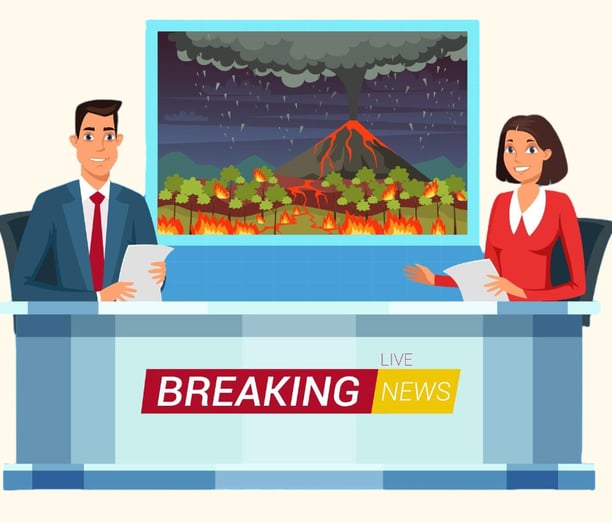Monitoring News
Use battery-powered radios or solar-charged devices to follow trusted news sources. Staying informed through reliable news sources is critical in survival or emergency scenarios. Monitoring the news provides you with real-time updates on the situation, enabling you to make informed decisions, avoid danger, and plan effectively. Here's a detailed explanation of how and why to monitor the news during a crisis.
STAY INFORMED
12/26/20243 min read
Monitoring News
Use battery-powered radios or solar-charged devices to follow trusted news sources. Staying informed through reliable news sources is critical in survival or emergency scenarios.
Monitoring the news provides you with real-time updates on the situation, enabling you to make informed decisions, avoid danger, and plan effectively. Here's a detailed explanation of how and why to monitor the news during a crisis.


1. Importance of Monitoring News
A. Real-Time Updates
Provides timely information about developing threats, evacuation orders, or changes in the crisis.
For instance, knowing the progress of a natural disaster or shifts in conflict zones helps you act proactively.
B. Avoids Misinformation
Helps you differentiate between verified facts and rumours circulating within the community or on social media.
C. Guides Resource Allocation
Informs you about aid distribution points, relief efforts, and availability of essential supplies.
D. Supports Decision-Making
Offers clarity on whether to stay put, evacuate, or change strategies.
2. Methods for Monitoring News
A. Emergency Radios
Why Use Them: Radios are reliable when other communication systems fail, such as during power outages or internet disruptions.
Recommended Features: Battery-powered, solar-powered, or hand-crank radios with access to AM/FM and NOAA weather channels.
B. Television and Online News
TV: Provides visuals and updates from local or national channels, especially helpful for evacuation details.
Online Sources: Social media platforms, official government websites, and news apps often provide real-time updates.
C. Mobile Alerts
Sign up for SMS or app-based alerts from government agencies or disaster management organizations.
Examples include FEMA alerts (in the US) or notifications from local emergency services.
D. Community Communication
Word of Mouth: Neighbors, local authorities, and community leaders can be valuable sources of updates.
Community Boards: Keep an eye on local bulletins or notice boards in shelters or gathering places.
3. Choosing Reliable News Sources
A. Government and Official Channels
National or local disaster management agencies provide accurate and timely information.
Examples: FEMA, Red Cross, or local emergency management departments.
B. Established News Outlets
Rely on well-known, reputable organizations with a track record of accurate reporting.
C. Avoid Unverified Sources
Be cautious of social media posts, chain messages, or unofficial statements that might spread misinformation.
D. Cross-Check Information
Verify breaking news with multiple sources to ensure accuracy.
4. What to Focus on When Monitoring News
A. Weather Updates
Monitor forecasts, storm tracks, and temperature changes to prepare for weather-related challenges.
B. Conflict Zones
Stay updated on locations of active hostilities, checkpoints, or areas to avoid.
C. Aid Distribution
Look for announcements about where to find food, water, medical aid, and shelter.
D. Transportation and Evacuation
Keep track of open roads, traffic conditions, public transport availability, and evacuation orders.
E. Health Alerts
Be aware of disease outbreaks, vaccination drives, or hygiene advisories in the affected area.
5. Practical Tips for Monitoring News
A. Backup Plans
Have multiple ways to access news (radio, mobile apps, or word of mouth) in case one fails.
B. Keep Devices Charged
Use solar chargers, power banks, or hand-crank devices to ensure communication tools remain functional.
C. Set Alarms
Set reminders to check news updates at regular intervals to stay informed without becoming overwhelmed.
D. Use Technology Wisely
Follow verified accounts and enable notifications on platforms like Twitter for real-time updates from official sources.
E. Maintain Awareness
Even when not actively monitoring, keep an ear out for broadcasts or announcements in the background.
6. Challenges and Solutions
A. Overload of Information
Challenge: Too many updates can be overwhelming.
Solution: Focus on updates from trusted sources and set time intervals for checking.
B. Misinformation
Challenge: False news can cause panic or poor decisions.
Solution: Verify news from multiple reliable sources before acting.
C. Accessibility Issues
Challenge: Lack of access to electricity, internet, or devices.
Solution: Use battery-powered radios or seek updates from neighbours or community leaders.
7. Benefits of Staying Updated
Prevents Panic: Accurate and timely information helps you stay calm and prepared.
Improves Safety: Enables better decisions on evacuation, travel, or resource use.
Fosters Collaboration: Sharing reliable news strengthens trust and cooperation within a group.
Monitoring news during a crisis is essential for survival and effective decision-making. By relying on reliable sources, using diverse communication tools, and staying vigilant, you can navigate challenges with greater confidence and ensure the safety of yourself and others.






